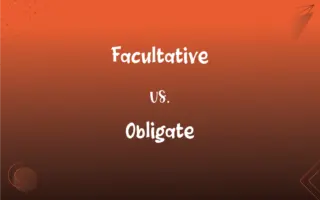Acetal vs. Hemiacetal: What's the Difference?
Edited by Aimie Carlson || By Harlon Moss || Updated on October 24, 2023
Acetal is a compound formed by the reaction of an aldehyde with an alcohol; hemiacetal results from the reaction of an aldehyde with its own hydroxyl group.

Key Differences
Acetal is a derivative of an aldehyde or ketone that results from its reaction with an alcohol. This reaction typically requires the presence of an acid catalyst and results in the formation of a compound containing two -OR groups. On the other hand, hemiacetal is a transient intermediate compound formed during the process that leads to the creation of an acetal. It results from the reaction of an aldehyde with its own hydroxyl group.
In terms of structure, an acetal contains two ether groups (-C-O-R) attached to the same carbon, whereas a hemiacetal has an ether group and a hydroxyl group (-OH) attached to that carbon. This structural distinction is important because it governs their reactivity and stability. Acetals are generally stable in both acidic and basic conditions, while hemiacetals are more unstable and can readily convert into acetals under certain conditions.
Acetals are commonly used as protective groups in organic synthesis because of their stability. They prevent certain functional groups from reacting under particular conditions. Hemiacetals, due to their transient nature, are not typically used for such purposes. Instead, they are intermediate compounds that can be isolated but are more commonly observed in equilibrium mixtures.
It's crucial for chemists to understand the distinction between acetal and hemiacetal, especially in carbohydrate chemistry. Sugars often exist in cyclic forms, and these cyclic forms are typically hemiacetals. Recognizing this can provide insights into the reactivity and behavior of these molecules.
Comparison Chart
Origin
Reaction of aldehyde with alcohol
Aldehyde reacting with its hydroxyl
ADVERTISEMENT
Structural Elements
Two ether groups (-C-O-R)
One ether group and one hydroxyl
Stability
Stable in acidic and basic conditions
Less stable
Common Use
Protective groups in organic synthesis
Intermediate in acetal formation
Presence in Sugars
Rare
Common in cyclic forms
Acetal and Hemiacetal Definitions
Acetal
A derivative from an aldehyde's reaction with alcohol.
In the synthesis, the aldehyde was converted to an acetal for protection.
ADVERTISEMENT
Hemiacetal
Contains both an ether group and a hydroxyl on the same carbon.
The hemiacetal structure was identified by the presence of both ether and hydroxyl functions.
Acetal
A compound with two -OR groups from the same carbon.
The acetal was formed with two methoxy groups attached to the central carbon.
Hemiacetal
Less stable compared to its acetal counterpart.
Over time, the hemiacetal converted into the more stable acetal in the solution.
Acetal
Does not have a hydroxyl group attached to its functional carbon.
On examination, the molecule was confirmed as an acetal due to the absence of a hydroxyl group.
Hemiacetal
Intermediate step in acetal formation.
The reaction mechanism indicated a hemiacetal formation before the final acetal product.
Acetal
A stable entity in both acidic and basic conditions.
The compound remained unaffected as an acetal in the reaction conditions.
Hemiacetal
A transient compound formed from an aldehyde and its hydroxyl.
Upon addition of the reagent, a hemiacetal was briefly observed.
Acetal
Often used as a protective group in organic synthesis.
To prevent unwanted reactions, the functional group was converted into an acetal.
Hemiacetal
Commonly found in cyclic forms of sugars.
Glucose in its ring form is a classic example of a hemiacetal.
Acetal
A colorless, flammable, volatile liquid, C6H14O2, used in perfumes and as a solvent.
Hemiacetal
(organic chemistry) Any of a class of compounds of general formula R1R2C(OH)OR' (where R' is not H and R1 or R2 is often hydrogen).
Hemiacetal
An organic compound usually formed as an intermediate product in the preparation of acetals from aldehydes or ketones
FAQs
Are hemiacetals common in sugars?
Yes, sugars often exist in cyclic forms that are typically hemiacetals.
What is an acetal?
Acetal is a compound formed from an aldehyde's reaction with an alcohol, containing two -OR groups.
Are acetals stable?
Yes, acetals are generally stable in both acidic and basic conditions.
Why are hemiacetals less stable than acetals?
Hemiacetals have both a hydroxyl and an ether group on the same carbon, making them more reactive.
How is a hemiacetal formed?
A hemiacetal forms when an aldehyde reacts with its own hydroxyl group.
Are hemiacetals commonly isolated?
Hemiacetals are transient and less stable, making them less commonly isolated than acetals.
Can a hemiacetal convert into an acetal?
Yes, hemiacetals can readily convert into acetals under certain conditions.
Is the formation of hemiacetals reversible?
Yes, the formation of hemiacetals is reversible and is often in equilibrium in a solution.
Do ketones form acetals?
Yes, ketones can react with alcohols to form acetals.
How are acetals hydrolyzed?
Acetals can be hydrolyzed back to aldehydes or ketones using acidic conditions.
Why are hemiacetals considered intermediates in acetal formation?
Hemiacetals are the compounds formed en route to acetal formation and are not the final stable product.
Do hemiacetals have chiral centers?
Hemiacetals can have chiral centers, especially in the context of carbohydrates.
Can you find both acetal and hemiacetal forms in a solution?
Yes, in some conditions, both acetal and hemiacetal forms can be in equilibrium in a solution.
Is the acetal formation an equilibrium process?
Yes, acetal formation is an equilibrium process, and conditions can shift the equilibrium towards either the reactants or products.
Why are acetals used as protective groups?
Acetals can protect sensitive functional groups from reacting under specific conditions due to their stability.
How can you differentiate between an acetal and hemiacetal structurally?
Acetals have two -OR groups, while hemiacetals have one -OR group and one hydroxyl group.
Are all cyclic sugars hemiacetals?
Not all, but many cyclic sugars exist as hemiacetals.
What role do acid catalysts play in acetal formation?
Acid catalysts facilitate the formation of acetals by protonating the carbonyl oxygen, making it more electrophilic.
Can acetals be formed from primary alcohols?
Yes, primary alcohols can react with aldehydes or ketones to form acetals.
What happens when a hemiacetal is exposed to an alcohol?
A hemiacetal can react with an alcohol to form an acetal.
About Author
Written by
Harlon MossHarlon is a seasoned quality moderator and accomplished content writer for Difference Wiki. An alumnus of the prestigious University of California, he earned his degree in Computer Science. Leveraging his academic background, Harlon brings a meticulous and informed perspective to his work, ensuring content accuracy and excellence.
Edited by
Aimie CarlsonAimie Carlson, holding a master's degree in English literature, is a fervent English language enthusiast. She lends her writing talents to Difference Wiki, a prominent website that specializes in comparisons, offering readers insightful analyses that both captivate and inform.































































